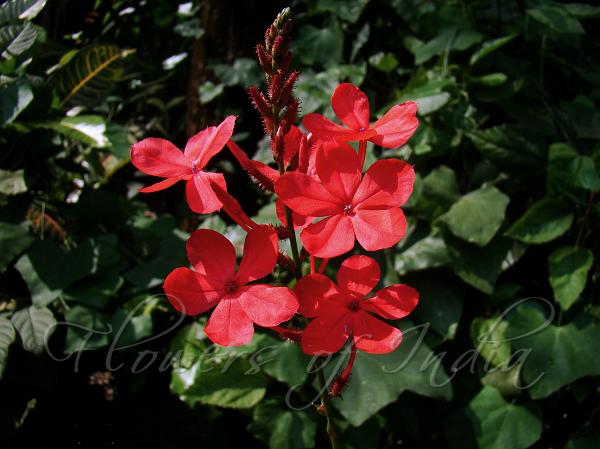|
| Lal Chitrak |
|

|

| File size | 1023228 |
| Original date | 12/6/09 11:41 AM |
| Resolution | 2048 x 1536 |
| Flash | Flash did not fire, auto |
| Focal length | 5.3mm |
| Exposure time | 1/250s |
| Aperture | 5.0 |
| Focus Distance | |
| Metering Mode | Multi-segment |
| Camera make | SONY |
| Camera model | DSC-H50 |
| Sensor type |
|
|
|
Photo: |
Botanical name: Plumbago indica Family: Plumbaginaceae (Plumbago family)
Synonyms: Plumbago rosea, Thela coccinea
Synonyms: Plumbago rosea, Thela coccinea
Lal Chitrak is a plant commonly cultivated in gardens throughout
India. This winter flowering plant begins to show off
its soft red, festive colors in time for winters. A nice change from the
traditional poinsettia, this Indian native continues to flower for months
to come. Lal Chitrak makes an outstanding container plant for a sunny window.
Watch with fascination how the flowers keep emerging on the same flower spike
from winter until spring. This is an erect or spreading, more or less
branched, herbaceous or half-woody plant 1.5 meters or less in height.
The leaves are ovate to oblong-ovate, 8 to 13 centimeters long, slightly
drooping, and smooth, with entire, undulate or wavy margins, pointed or blunt
tip, and pointed base. The spikes are 15 to 30 centimeters long. The calyx
is tubular, 8 to 10 millimeters long, and covered with
stalked, sticky glands. The corolla is bright red, the tube is slender and
about 2.5 centimeters long, and the limb, which spreads, is about 3 cm in
diameter.
Medicinal uses: The root is acrid, vesicant, abortifacient and a
stimulant. Applied in bland oil, it is used externally or internally in
rheumatism and paralytic afflictions. The root is powerful sialogogue and a
remedy for secondary syphilis, leprosy and leucoderma.
The milky juice of the plant is used in ophthalmia and in scabies.
The root is acrid, vesicant, abortifacient and a
stimulant. Applied in bland oil, it is used externally or internally in
rheumatism and paralytic afflictions. The root is powerful sialogogue and a
remedy for secondary syphilis, leprosy and leucoderma.
The milky juice of the plant is used in ophthalmia and in scabies.
Medicinal uses:
 The root is acrid, vesicant, abortifacient and a
stimulant. Applied in bland oil, it is used externally or internally in
rheumatism and paralytic afflictions. The root is powerful sialogogue and a
remedy for secondary syphilis, leprosy and leucoderma.
The milky juice of the plant is used in ophthalmia and in scabies.
The root is acrid, vesicant, abortifacient and a
stimulant. Applied in bland oil, it is used externally or internally in
rheumatism and paralytic afflictions. The root is powerful sialogogue and a
remedy for secondary syphilis, leprosy and leucoderma.
The milky juice of the plant is used in ophthalmia and in scabies. | Identification credit: Tabish | Photographed in Alibag, Maharashtra. |
• Is this flower misidentified? If yes,